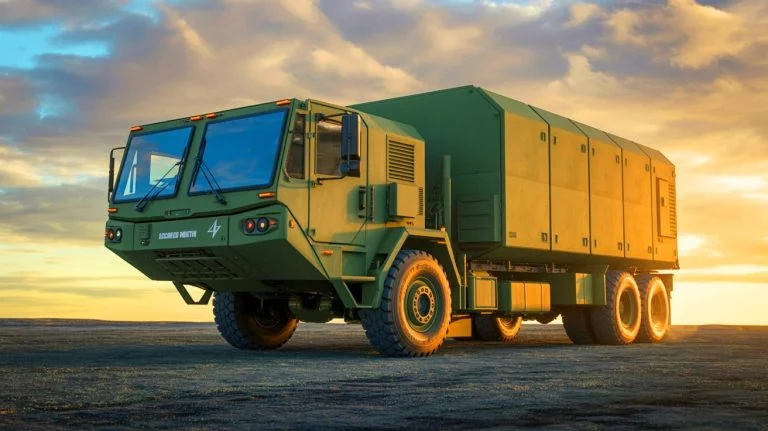| IN A NUTSHELL |
|
Lockheed Martin’s recent announcement regarding its development of the Common Multi-Mission Truck (CMMT) system has sent ripples through the defense industry. This innovative, low-cost vehicle, designed to carry a variety of payloads, signals a significant shift in military technology. With its recent successful tests, Lockheed is positioning the CMMT as a game-changer in the realm of standoff munitions. This article delves into the details of the CMMT system, its capabilities, and its potential impact on the military landscape.
The CMMT-D and CMMT-X: A New Era of Low-Cost Munitions
The CMMT system comprises two distinct versions: the CMMT-D and the CMMT-X. The CMMT-D, an unpowered glide vehicle, is designed for deployment from cargo aircraft using a pallet system, while the CMMT-X, equipped with a motor, launches from the bottom of a smaller aircraft. These designs reflect Lockheed Martin’s emphasis on affordability and versatility. The CMMT-D boasts a range of about 500 nautical miles, making it a formidable option for diverse military applications. In contrast, the CMMT-X, with a range of 350 nautical miles, focuses on flexibility and rapid deployment. Both vehicles underscore Lockheed’s commitment to revolutionizing military tactics by providing cost-effective, scalable solutions.
The introduction of these vehicles aligns with a growing military demand for low-cost standoff munitions. Lockheed’s innovative approach integrates different launch methods, including pylon-launched, pallet-launched, and vertical launch variations. Notably, the CMMT-D is anticipated to have a unit cost of approximately $150,000, which is strikingly affordable compared to the high-end AGM-158 Joint Air-to-Surface Missile. This affordability allows for mass production and deployment, offering a strategic advantage by enabling the military to maintain a robust arsenal without incurring prohibitive costs.
Innovative Testing and Deployment Techniques
Lockheed Martin’s testing of the CMMT-D and CMMT-X vehicles has demonstrated the practical application of these systems. The CMMT-D was dropped from a Rapid Dragon-type pallet cell, simulating a parachute descent from a fixed-wing airlifter. This method mirrors the Air Force’s recent use of pallets for deploying munitions from cargo aircraft. In a recent test, the CMMT-D successfully deployed its wings and executed an unpowered glide to the surface, marking a significant milestone in affordable cruise missile deployment.
The CMMT-X, on the other hand, was launched from a pylon under a Piper Navajo turboprop. After separation, the vehicle deployed its wings, and its engine ignited for powered flight. This achievement highlights Lockheed’s ability to rapidly transition from concept design to real-world application. Notably, the CMMT-X is a direct descendant of the 2020 “SPEED RACER” concept, which explored expendable systems. This lineage emphasizes the company’s commitment to leveraging past innovations to expedite the development of new technologies.
Digital Innovations in Design and Production
Lockheed Martin’s development process for the CMMT vehicles has been accelerated by digital design techniques. These methods have allowed the company to reduce the time from concept to preliminary design review significantly. Lockheed noted that it completed the design review for the CMMTs in half the usual time, facilitated by prior work on the SPEED RACER project. This digital approach not only expedites the development timeline but also enhances the potential for scalable production.
The use of digital methods underscores Lockheed’s strategic focus on efficiency and adaptability. By integrating advanced digital tools into the design process, Lockheed is setting a new standard for rapid technology deployment. This approach not only benefits the company’s current projects but also positions it as a leader in the development of future military technologies. The CMMT system exemplifies how digital innovation can drive progress in defense applications, enabling the military to respond swiftly to evolving threats.
Future Implications and Potential Applications
The CMMT system’s successful testing positions it as a potential asset for the Collaborative Combat Aircraft (CCA) program. Although the Air Force has not finalized the characteristics for the next phase of the CCA program, Lockheed’s flight-tested design and developed architecture could be quickly adapted to meet emerging requirements. This adaptability is crucial as military technology evolves to address new challenges.
Lockheed’s focus on low-cost, scalable solutions aligns with broader defense industry trends. As the military seeks to enhance its capabilities while managing budget constraints, systems like the CMMT offer a viable pathway to achieving these goals. By emphasizing affordability and rapid deployment, Lockheed is not only meeting current demands but also anticipating future needs.
As Lockheed continues to innovate and refine its technologies, the question remains: How will the integration of such systems reshape the future of military operations and strategic planning?
Did you like it? 4.5/5 (26)







Wow, only $150K for a cruise missile? That’s cheaper than my student loans! 😂
I’m curious about the environmental impact of these drones. Any information on that?
Great article, but I’d love more details on the potential applications in civilian sectors.
How does the CMMT-X compare to other existing military drones in terms of speed and power?
Are these drones part of any active military operations yet?
So, is the $150K price tag just introductory, or will it stay that way?
It’s amazing how technology is advancing. What’s next, flying cars for military use? 🚗✈️
Is Lockheed planning to sell these internationally or keep them for domestic use only?
Doesn’t make sense. 350 miles for powered missile but 500 miles for glide/unpowered missile ???!! sure you aren’t repeating typo of 50 miles ?????
Why haven’t I heard about this until now? Seems like a huge deal!
With advancements like these, will traditional manned aircraft become obsolete?
Digital design techniques are the future. Can’t wait to see more innovations! 🌟
Does the CMMT system integrate with existing military technology seamlessly?
How does Lockheed keep the cost so low? Seems too good to be true. 🤔
Is there a way to see these drones in action, like a demo or something?
Who else is competing with Lockheed in this space? Boeing, maybe?
These are exciting times for military tech, but is it safe to produce such weapons at scale?
I wonder how these drones will affect defense contracts and negotiations worldwide.
Are there any plans to make these drones autonomous, or will they always require remote control?
Honestly, $150K for a cruise missile sounds like a bargain. 😮
What are the ethical implications of making military technology more affordable? 🤔
It’s incredible that they completed the design review in half the time. Go Lockheed! 🚀
Would love a follow-up article on how digital design is transforming other industries.
The CMMT-D sounds like a real powerhouse. Can’t wait to learn more about its missions.
How does the CMMT system align with global disarmament efforts, if at all?
Is this the end of expensive military contracts? Or just the beginning of a new era?
How do these drones compare to the ones being developed by China and Russia? 🛩️
Can’t help but feel a bit uneasy about cheaper weapons. Hope they’re used responsibly.
This sounds like a game-changer for military budgets. Thanks for the detailed info!
Can these drones be used for humanitarian purposes, or are they strictly military?
If these are so affordable, does that mean every country will have them soon?
What measures are in place to ensure these drones don’t fall into the wrong hands?
Lockheed’s digital design approach is fascinating. Are other companies doing this too?
Not sure how I feel about more affordable weapons. Is this really a good thing? 🤷
The versatility of the CMMT system is impressive. Kudos to Lockheed!